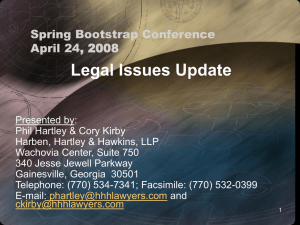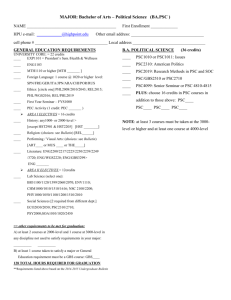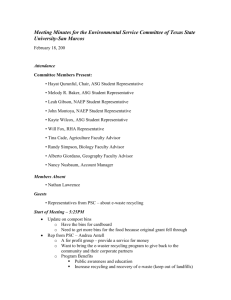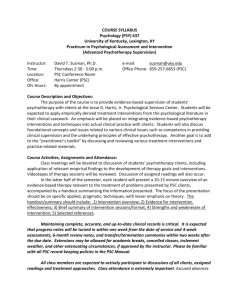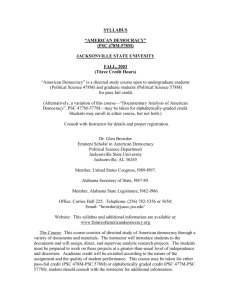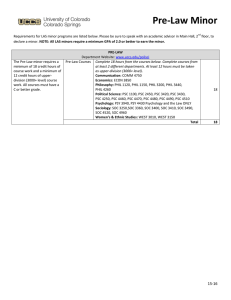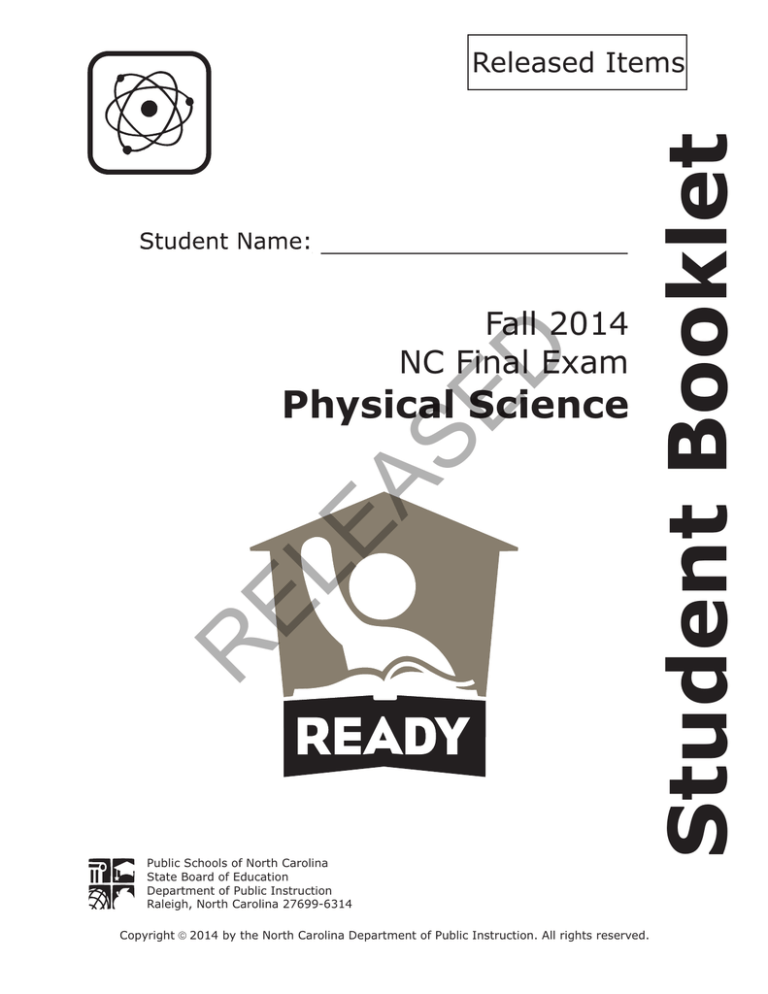
D
Fall 2014
NC Final Exam
R
EL
EA
SE
Physical Science
Public Schools of North Carolina
State Board of Education
Department of Public Instruction
Raleigh, North Carolina 27699-6314
Copyright ã 2014 by the North Carolina Department of Public Instruction. All rights reserved.
Student Booklet
Released Items
PHYSICAL SCIENCE—RELEASED ITEMS
soft drink
B
oxygen gas
C
water
D
fog
Mg and Cl
B
N and O
C
Fe and Co
D
Rb and Al
SE
A
D
Atoms of which two elements will form an ionic bond?
EA
3
A
Which compound will most likely be formed when lithium (Li) and nitrogen (N)
are chemically combined?
A
LiN
B
Li3N
C
LiN3
D
Li3N3
EL
2
Which substance is most likely classified as a colloid?
R
1
1
Go to the next page.
PHYSICAL SCIENCE—RELEASED ITEMS
A
NH4Cl
B
K2SO4
C
NaCl
D
C6H12O6
D
Why are beta particles able to penetrate objects better than alpha particles are?
because beta particles are larger than alpha particles
B
because beta particles are smaller than alpha particles
C
because beta particles are negatively charged, while alpha particles are
neutral
D
because beta particles travel in a straight line, while alpha particles travel in
waves
EA
SE
A
EL
5
Which compound results from covalent bonding?
R
4
2
Go to the next page.
PHYSICAL SCIENCE—RELEASED ITEMS
This graph represents the cooling curve for a pure substance in a liquid state at
t = 0 min.
60
50
40
20
10
0
1
2
3
4
D
30
5
6
SE
Temperature (°C)
Cooling Curve
Time (min)
EA
Why does temperature remain constant from when t = 2 min to when t = 5 min?
because the substance absorbs heat energy as it changes from a liquid to a
solid
B
because heat energy is released from the substance as it changes from a
liquid to a solid
C
because heat energy is released from the substance as it changes from a
liquid to a gas
D
because the substance absorbs heat energy as it changes from a liquid to a
gas
EL
A
R
6
3
Go to the next page.
PHYSICAL SCIENCE—RELEASED ITEMS
7
This diagram represents a closed series circuit.
6.1
5.1
21 V
What would happen if the voltage were doubled?
B
The current would double.
C
The current would remain constant.
D
The current would be reduced by half.
EA
SE
D
The current would quadruple.
How would decreasing the diameter of the wires in a circuit influence the
resistance and flow of electrons in the circuit?
It would decrease the resistance, causing fewer electrons to flow through the
circuit.
B
It would increase the resistance, causing fewer electrons to flow through the
circuit.
C
It would decrease the resistance by allowing more electrons to flow through
the circuit.
D
It would increase the resistance by allowing more electrons to flow through
the circuit.
EL
A
R
8
A
4
Go to the next page.
PHYSICAL SCIENCE—RELEASED ITEMS
A
by reducing the length of the core of the electromagnet
B
by using rubber material as the core for the electromagnet
C
by decreasing the amount of current in the electromagnet
D
by increasing the number of coils in the wires of the electromagnet
D
How does a step-down transformer alter the amount of voltage from a power line
to a building?
It increases output voltage by increasing the number of wire turns in the
secondary coil.
B
It decreases output voltage by decreasing the number of turns in the
secondary coil.
C
It increases output voltage by decreasing the number of wire turns in the
secondary coil.
D
It decreases output voltage by increasing the number of turns in the
secondary coil.
EA
SE
A
EL
10
How could the strength of an electromagnet be increased?
R
9
5
Go to the next page.
PHYSICAL SCIENCE—RELEASED ITEMS
The resultant force on the box would be 8 N.
B
The resultant force on the box would be 18 N.
C
The box will move toward Student X.
D
The box will move toward Student Y.
D
A
SE
A ball at rest is dropped and hits the ground in 1.5 s with a final speed of 15 m/s.
How would the acceleration and final speed of the ball be affected if it were
dropped from a greater height on Earth? (Ignore friction.)
Its final speed would remain the same because its rate of acceleration would
remain the same.
B
Its final speed would increase because its rate of acceleration would remain
the same.
C
Its final speed would remain the same because its rate of acceleration would
decrease.
D
Its final speed would increase because its rate of acceleration would
increase.
EA
A
EL
12
Student X pushes a 10-N box with a force of 2 N. At the same time, Student Y
pushes the same box with a force of 6 N, but in the opposite direction. Which
would most likely occur? (Ignore friction.)
R
11
6
Go to the next page.
PHYSICAL SCIENCE—RELEASED ITEMS
This diagram represents a neutral atom of fluorine-19.
D
Which best describes the structure of fluorine-19?
2 electrons in the first energy level; 7 electrons in the second energy level
B
2 electrons in the first energy level; 8 electrons in the second energy level
C
9 protons and 9 neutrons in the nucleus
D
10 protons and 9 neutrons in the nucleus
EL
EA
SE
A
R
13
7
Go to the next page.
PHYSICAL SCIENCE—RELEASED ITEMS
This is the end of the Physical Science Released Items.
Directions:
1. Look back over your answers for the test questions.
2. Make sure all your answers are entered on the answer sheet. Only what is
entered on your answer sheet will be scored.
3. Put all of your papers inside your test book and close the test book.
D
4. Place your calculator on top of the test book.
SE
5. Stay quietly in your seat until your teacher tells you that testing is
finished.
R
EL
EA
6. Remember, teachers are not allowed to discuss items from the test with
you, and you are not allowed to discuss with others any of the test
questions or information contained within the test.
8
PHYSICAL SCIENCE — RELEASED ITEMS
Type2
Key
Percent Correct3
Standard
1
MC
D
30%
PSc.2.1.1
2
MC
A
49%
PSc.2.2.2
3
MC
B
50%
PSc.2.2.3
4
MC
D
23%
PSc.2.2.2
5
MC
B
35%
PSc.2.3.1
6
MC
B
48%
PSc.3.1.1
7
MC
B
64%
PSc.3.3.2
8
MC
B
34%
PSc.3.3.3
MC
D
61%
PSc.3.3.4
MC
B
30%
PSc.3.3.5
MC
C
58%
PSc.1.2.3
MC
B
16%
PSc.1.2.1
MC
A
76%
PSc.2.1.4
11
12
13
EA
EL
10
R
9
SE
Item Number
D
Physical Science
RELEASED Items1
Fall 2014
Answer Key
1
PHYSICAL SCIENCE — RELEASED ITEMS
1
These released items were administered to students during a previous test administration. This
sample set of released items may not reflect the breadth of the standards assessed and/or the
range of item difficulty found on the NC Final Exam. Additional items may be reviewed at
http://www.ncpublicschools.org/accountability/common-exams/released-forms/. Additional
information about the NC Final Exam is available in the Assessment Specification for each exam
located at http://www.ncpublicschools.org/accountability/common-exams/specifications/.
2
This NC Final Exam contains only multiple-choice (MC) items.
3
R
EL
EA
SE
D
Percent correct is the percentage of students who answered the item correctly during the
Spring 2014 administration.
2
PHYSICAL SCIENCE — RELEASED ITEMS
Standard Descriptions
Only clarifying objective descriptions addressed by the released items in this booklet are listed
below. A complete list of the North Carolina Essential Standards for Science and Social studies
may be reviewed at http://www.ncpublicschools.org/acre/standards/new-standards/.
PSc.1.2.1 (Forces and Motion)
Explain how gravitational force affects the weight of an object and the velocity of an object in
freefall.
PSc.1.2.3 (Forces and Motion)
Explain forces using Newton’s Three Laws of Motion.
D
PSc.2.1.1 (Matter: Properties and Change)
Classify matter as: homogeneous or heterogeneous; pure substance or mixture; element or
compound; metals, nonmetals or metalloids; solution, colloid or suspension.
SE
PSc.2.1.4 (Matter: Properties and Change)
Interpret data presented in Bohr model diagrams and dot diagrams for atoms and ions of
elements 1 through 18.
EA
PSc.2.2.2 (Matter: Properties and Change)
Infer the type of chemical bond that occurs, whether covalent, ionic or metallic, in a given
substance.
PSc.2.2.3 (Matter: Properties and Change)
Predict chemical formulas and names for simple compounds based on knowledge of bond
formation and naming conventions.
EL
PSc.2.3.1 (Matter: Properties and Change)
Compare nuclear reactions including; alpha decay, beta decay and gamma decay; nuclear fusion
and nuclear fission.
R
PSc.3.1.1 (Energy: Conservation and Transfer)
Explain thermal energy and its transfer.
PSc.3.3.2 (Energy: Conservation and Transfer)
Explain simple series and parallel DC circuits in terms of Ohm’s Law.
PSc.3.3.3 (Energy: Conservation and Transfer)
Explain how current is affected by changes in composition, length, temperature, and diameter of
wire.
PSc.3.3.4 (Energy: Conservation and Transfer)
Explain magnetism in terms of domains, interactions of poles, and magnetic fields.
PSc.3.3.5 (Energy: Conservation and Transfer)
Explain the practical applications of magnetism.
3

